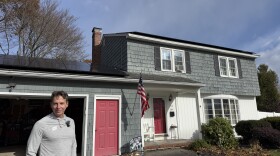Yesterday, a new report was released with suggestions for how Seacoast communities should prepare for the effects of climate change. The document could influence town planning and development in the region for years.
The report came from the Coastal Risk and Hazards Commission, which was created by the legislature back in 2013. It had 37-members representing Seacoast towns, state agencies, and private-sector interests.
Their report identifies where the Seacoast is vulnerable to the effects of climate change and suggests a slew of recommendations for how towns and state and local agencies should respond.
Fred Rice is a Republican state rep from Hampton and a member of the commission.
“This report is a contingency plan, it’s not a mandate. These are guidelines for each of the municipalities that touch water here on the Seacoast of New Hampshire – steps for them to consider when they’re developing their own emergency plans.”
Those guidelines include updating zoning and building regulations to incorporate sea-level rise projections, as well as a new position with a state agency that would coordinate regional efforts.
--
NHPR's Seacoast Reporter Jason Moon joined All Things Considered Host Peter Biello to talk about the report and what it means for the Seacoast.
So, this report came from something called the Coastal Risk and Hazards Commission. I know it was created by the legislature back in 2013 – but who was on the commission and what exactly was their mission?
The commission was made up of 37 people from a variety of Seacoast perspectives. Most were from local and state government -- each of the region’s 17 cities and towns had a member, as well as some state reps and senators from the region. There were also people from the private sector, like the Seacoast Board of Realtors and the New Hampshire Home Builders Association.
So you had a variety of public and private perspectives on the commission, but there was also some diversity in opinion on the commission when it came to the issue of climate change. Here’s Fred Rice, a Republican State Rep from Hampton talking about this today at the press conference.
“Now when you’re talking about anything that has to do with climate change, sea-level rise, subjects of that nature, there’s an 800-pound gorilla in the room. And that 800-pound gorilla is that not everyone subscribes to those beliefs.”
Rice counts himself among those more skeptical of climate change. And he brought that up to make a point that even he signed off on the recommendations made in the report.
Well before we get to what the report recommends, what do we know about how climate change is going to affect New Hampshire’s seacoast, specifically?
That’s actually something that the report deals with in detail. The commission spent much of the past three years gathering the latest climate change science and applying it to New Hampshire to find out where we are most vulnerable.
And the takeaway is that over the long term, there could be some pretty significant challenges ahead.
The sea-level rise projections in the report say that by 2050, the Seacoast will be looking at a sea-level rise of between a half-foot and 2 feet. By 2100 that range is from about one-and-a-half feet to over 6 feet.
And the report digs down to look at what those scenarios would actually mean for Seacoast communities.
So for instance, if you take the intermediate scenario of a 4 foot rise in sea-level, for just the seven towns on the Atlantic coast that would mean a loss of about 2600 acres, 33 critical municipal facilities, and about 25 miles of road, including parts of iconic Route 1-A, which runs along the Atlantic coast.
Ok, so what does the report say the Seacoast should do to prepare for all that? Are there plans for a giant New Hampshire seawall?
No, it’s actually kind of like the opposite of a giant seawall.
Basically, Seacoast towns are going to have deal with a lot of the effects of climate change on a site-by-site basis.
So the report recommends that towns update their zoning regulations that control where and how new homes are built. It also recommends that towns use sea-level rise projections in their master planning. So when, say, Rye wants to build a new road, or a new culvert, or even a new school, they take into account where the sea-level will be in the future.
Meanwhile, the report recommends that the state create a new position at the Department of Environmental Services that would spearhead these efforts and coordinate some regional cooperation.
So, less of a giant seawall project and more like a thousand tiny projects.
So how likely is it that these recommendations will be acted on?
It’s hard to say. These recommendations are just that -- recommendations.
The chairman of the commission, Cliff Sinnott addressed this today. He said towns have disincentives to act because a.) some of the effects of climate change are a long way off and b.) we don’t know exactly how bad it’s going to be. But he then said this:
“We believe very strongly that this would be a very costly mistake, because if we don’t take some basic steps to prepare early, the problem and the costs of dealing with it become much greater. It is estimated that for every dollar spent on improving resiliency, four dollars is returned in future disaster recovery costs.”
One thing that suggests at least some of the recommendations will be followed is that many of the people who can act on them are the same people who were on the commission.








